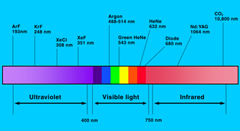

Click image to enlarge Fig. 1 Electromagnetic spectrum of lasers used in eye surgery. |
The origin of light treatment to the eye dates back to 400 BC, when Plato recognized the power of light and described the dangers of staring directly at the sun during an eclipse. In 1946, Gerd Meyer-Schwickerath, a German ophthalmologist, first demonstrated the use of light to coagulate retinal tissue (photocoagulation) in humans [1]: By focusing the light of a xenon arc lamp he induced small burns on the retina to seal retinal tears – a technique which was to revolutionize the treatment of eye diseases. The first functioning laser was built by the physicist Theodore Maiman in 1960, and the first clinical ophthalmic laser treatments in humans were reported by Charles Campell and coworkers in 1963 and Christian Zweng and coworkers in 1964 [2]. Because light can reach almost any ocular structure noninvasively, lasers have had a greater impact on ophthalmology than on any other field in medicine.
How Do Lasers Work?
'Laser' is an acronym for 'light amplification by stimulated emission of radiation'. Stimulated emission, first predicted theoretically by Albert Einstein in 1917, is the fundamental physical process that makes lasers possible. There are three basic interactions between light (photons) and electrons [3]: (1) Absorption – an atom absorbs a photon, which forces one of its electrons to move to a higher energy orbit. (2) Spontaneous emission – an atom in its excited state emits a photon when an electron falls back to a lower energy orbit. (3) Stimulated emission – a photon interacts with an atom that has energy stored and stimulates an electron to fall onto a lower energy orbit and produce a second photon, coherent with the first. There are many ways of producing light, but stimulated emission is the only known method that produces coherent light. For an output of just 1 mW, a minimium of 1016 stimulated emissions per second are necessary. The realization of this concept was so difficult that it took over half a century between the theoretical prediction of stimulated emission and the construction of a practical laser light source. Gas and solid-state lasers are the most widely used in clinical ophthalmology (fig. 1). In gas lasers, atoms of a working gas (e.g. argon or krypton) are enclosed in a cylindric tube and eventually one of the high-energy electrons undergoes spontaneous emission and generates a photon of the correct frequency to cause stimulated emission. By repeatedly reflecting the photons back and forth across the cylinder tube with the help of mirrors placed at opposite ends of the tube, a chain reaction of stimulated emission is produced. One mirror reflects totally and the other partially, and the relatively small amount of light that is allowed to pass through the partially reflecting mirror produces the laser beam, either continuously or pulsed. Lasers can have various effects on the target tissue depending on the wavelength and power used:
| • | Thermal: Absorption of laser energy (visible or infrared light) by tissue pigment results in temperature increase (e.g. photocoagulation, Ho:YAG). |
|
| • | Photochemical: Ultraviolet and visible light absorption induces the formation or destruction of chemical bonds (e.g. photodynamic therapy, excimer laser). |
|
| • | Mechanical: Plasma formation (optical breakdown) leads to tissue disruption (e.g. photodisruption with Nd:YAG) |
|
| • | Vaporization: Micro-explosion occurs due to the sudden rise in water temperature to above boiling point (e.g. Er:YAG) |
Ophthalmology was the first medical discipline to apply lasers as surgical tools. Over the last 30 years, lasers have become the treatment of choice for disorders involving almost every part of the eye, and we can distinguish their use in anterior segment, refractive, pediatric and retinal surgery.
The Beginnings
How Do Lasers Work?
Anterior Segment Surgery
Refractive Surgery
Pediatric Eye Surgery
Retinal Surgery
Conclusion
References
Biography
>> next